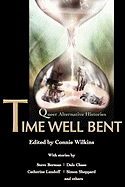 Time Well Bent: Queer Alternative Histories
Time Well Bent: Queer Alternative Histories
Edited by Connie Wilkins
Lethe Press. 184 pages, $15.
THE CHIEF PLEASURE of this varied anthology lies in its imaginative breadth. Editor Connie Wilkins has collected fourteen stories from established and emerging writers of GLBT fiction that speak to both the “queer” and the “histories” of the subtitle.
The editor’s introduction positions the collection as a corrective to the Western historical tradition, which has “either ignored, glossed over, or vilified” the presence and experiences of GLBT people. That this anthology offers an alternative through fiction rather than scholarship adds a twist to the volume’s central theme. These are queer stories about queered history.
The alternative history genre frees the contributors to play with this theme in a variety of ways. Some of the stories ask how our contemporary understanding of history might be different through a queer lens, if that lens were applied at crucial turning points in the past rather than as a political or cultural claim (or reclamation). For example, Emily Salter’s “A Happier Year” envisions how the sexual and romantic lives of her World War I–era gay characters might have been different if E. M. Forster had published Maurice in 1914, when it was written, rather than in 1970. Sometimes, as in C. A. Gardner’s “At Reading Station, Changing Trains” and Lisabet Sarai’s “Opening Night,” the changes come too late for writers who helped bring them about—T. E. Lawrence and William Gilbert (the father of W. S. Gilbert), respectively, in these two pieces.
Other stories drape a gay mantle on historical figures and imagine how an alternate identity might have affected critical events. “Morisca” by Erin MacKay poses such a question about 15th-century Spain’s Queen Isabella, while Dale Chase leads us to a very different Bill of Rights by way of Thomas Jefferson and his secretary-lover. The same is true for M. P. Ericson’s “A Spear against the Sky,” which places Cartimandua and Boudica in a gay-inflected first-century alliance against the Romans. And Catherine Lundoff’s “Great Reckonings, Little Rooms” makes great sport of a gender-bent Shakespeare sibling and a surviving Kit Marlowe.
Where stories in Time Well Bent layer GLBT themes onto colonialism, the effect is a dreamlike array of possibilities. Rita Oakes’ story “A Wind Sharp as Obsidian” allies a Mayan goddess with Meso-America’s “first mestiza” goddess against the invading Spaniards. In “The Final Voyage of the Hesperus,” Steve Adamson uses dream sequences to show how history treated Indian migrants to the West Indies in counterpoint to the “reality” of a migration free from colonial depredations and slavery. The European protagonist in Sandra Barret’s “Roanoke” benefits from her exposure to a Native third-gender tradition, so much so that the colony might actually survive.
The most intriguing tales in this collection are those that simply tell a story of a gay person making modest choices in the world as it was. As Barry Lowe asserts in the author’s note to “Sod ’Em”: “the deeds of the little people, those not prominent on the world history stage, can have widespread ramifications.” In Lowe’s story, the ripples flow from a humble Irish scribe’s rewriting of the Old Testament story of Lot and the Angels of Sodom on the eve of the 9th-century Viking invasions. In Steve Berman’s “The High Cost of Tamarind” and Connie Wilkins’ “The Heart of the Storm” local lore (revolutionary Mexico’s and Second World War Brittany’s) informs the actions of characters such that history itself isn’t altered overmuch, but our modern-day interpretation of events is thrown into question.
Finally, there’s Simon Sheppard’s “Barbaric Splendor,” which casts Coleridge’s “Kubla Khan” as history rather than fantasy. The result is queer reading of a text that results in a history that appears disturbingly close to the real thing. Wonderful as it is, Sheppard’s story is not alone in its muscular imagination, solid research, deft writing, and clean editing. This collection stands up equally well to dipping in anywhere to explore a favorite era and to reading these exercises in historical (re)discovery from cover to cover.





